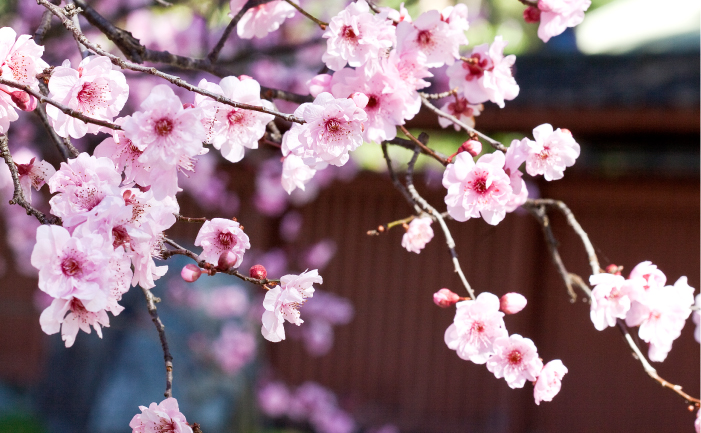The cherry blossom is the symbol of Japan, as well as being the symbol of spring. The blooming is celebrated in Japan with cherry blossom festivals, which are an attraction for both locals and tourists from around the world. For hundreds of years the Japanese have enjoyed themselves by picnicking under these blossoming trees in the spring.
Visits are made to mountains to view the wild cherries (usually wild forms of Prunus serrulata). In Tokyo and other centres the parks are planted with the Tokyo cherry, (P. x yedoensis). In temple gardens old specimens of P. subhirtella may also be seen.
But, you don’t have to go to Japan to enjoy cherry blossoms. These trees can be found in abundance in cold climate and mountain areas of Australia. To view the ornamental flowering cherries at their spring peak Peter Valder visited the aptly named ‘Cherry Cottage’ at Mt Wilson in the Blue Mountains of New South Wales.
Other places to view cherries in the Blue Mountains include the towns of Leura and Katoomba where flowering cherries are used as street trees and are in peak bloom in mid-October. Cherries can also be found in parts of the Dandenongs and in the Adelaide Hills and in cool climate gardens in much of southern Australia.
Plant details
Botanical name: There are many different species and cultivars of cherries but the most commonly grown in gardens is Prunus serrulata.
Common name: Japanese flowering cherry, oriental cherry
Family: Cherries are members of the rose family, Rosaceae.
Climate: These are cool climate plants which do best in mountain and tableland areas and other regions with cold winters and mild summers such as parts of Victoria, Tasmania. These trees will grow in the cooler, elevated districts of Sydney but may be short lived.
Climate map – Japanese flowering cherry, oriental cherry
Uses:
- The many different species and varieties cater for many different uses including:upright columns
- weeping specimens
- specimen tree
- shade tree
- autumn colour
- cut flowers
Likes:
- deep, well-drained soil
- a sunny position with shelter from hot winds in spring and summer
Dislikes:
- waterlogged soil
- hot or humid climates
Flowering times
Although flowering cherries are at their peak in spring, there are three main flowering times for the Japanese cherry. The expected size where given is shown as height and width.
Early: Prunus subhirtella is the first group to flower. Some well known examples of this include:
‘Autumnalis’ – upright shape with flowers beginning in autumn and continuing through winter. Pale pink flowers fade to white.
‘Pendula’ – a beautiful weeping shape which has palest pink flowers fading to white. Growing this on a 2-3m (6-10′) standard understock will show it off to its best.
‘Fukubana’ – an upright cherry with small, double, bright pink flowers.
Mid season: The early flowering cherries are then followed by:
Prunus x yedoensis (Tokyo cherry) which is a large tree with a possible height and width of 9m (to around 30′). The dark green foliage contrasts with the almond-scented single white flowers. This tree is widely planted in Tokyo where old specimens may be 15-20m tall (up to 60′). The Tokyo cherry is also the cherry that blooms in front of the White House in Washington.
Late: The late flowering cherries follow and the best of these include:
P. ‘Amanogawa’ – an upright specimen which has a shape similar to a pencil pine. This cherry has attractive semi-double shell-pink flowers which are fragrant and appear in late spring. Size: 10x4m (30×12′).
P. ‘Fugenzo’ and P. ‘Kanzan’ (Sekiyama) – have large double bright pink flowers and bronze young leaves.
P. ‘Mikuruma-gaeshi’ – palest pink flowers in dense clusters.
P. ‘Ojochin’ – large, single white flowers from pink buds. This flowering cherry with bronze young foliage. Size: 4.5×3.5m (16×10′) wide.
P. ‘Shirofugen’ – long stalked double white flowers with bronze leaves which turn to an orange-red colour during autumn. This fragrant flowering cherry is very late, almost the last to flower.
P. ‘Shirotae’ (Mt Fuji) – fragrant, semi-double white flowers with horizontal branches forming a low spreading shape. Size: 6x8m (18×25′).
P. ‘Shimidsu-sakura’ (Okumiyaku) – pink and white with pendulous flowers and gracefully spreading branches. The young green foliage puts on a dazzling autumn display. Size: up to 4x5m (12×15′).
P. ‘Tai Haku’ – sometimes called ‘The Great White Cherry’ this tree has very large single white flowers with bronze leaves. Size: A vigorous and spreading specimen which may grow to 8x6m (25×18′).
P. ‘Ukon’ – yellowish green semi-double flowers which appear from mid-October onwards. This tree has brown-bronze juvenile foliage. Size: height and spread to 10m (30′).
Warm climate cherries
People who live on the coast shouldn’t despair if they can’t grow Japanese cherries. Peter recommends trying Prunus campanulata (commonly known as the Formosan, Taiwanese or bell cherry) as this doesn’t require the cold climate that the others do. The frost hardy Formosan cherry grows to a height and spread of around 6-8m (18×25′) and has a slender habit. The deep rose-red flowers are seen in winter and are attractive to nectar feeding birds. It is one of the first cherries to flower.
Open garden
‘Cherry Cottage’ is at Queens Avenue, Mount Wilson in the Blue Mountains west of Sydney. It is open to the public during April and May and then from September until early November. There is a succession of flowering cherries from late August to October but they are at their peak during September and early October. As well as cherries, there are also massed planting of evergreen and deciduous azaleas, bulbs and many other cool climate plants. Cherry Cottage will close for this season this year on Sunday 9 November.
Further information
For details of gardens and features of the Blue Mountains call the Blue Mountains Tourist Authority. Phone: (02) 4739 6266.



